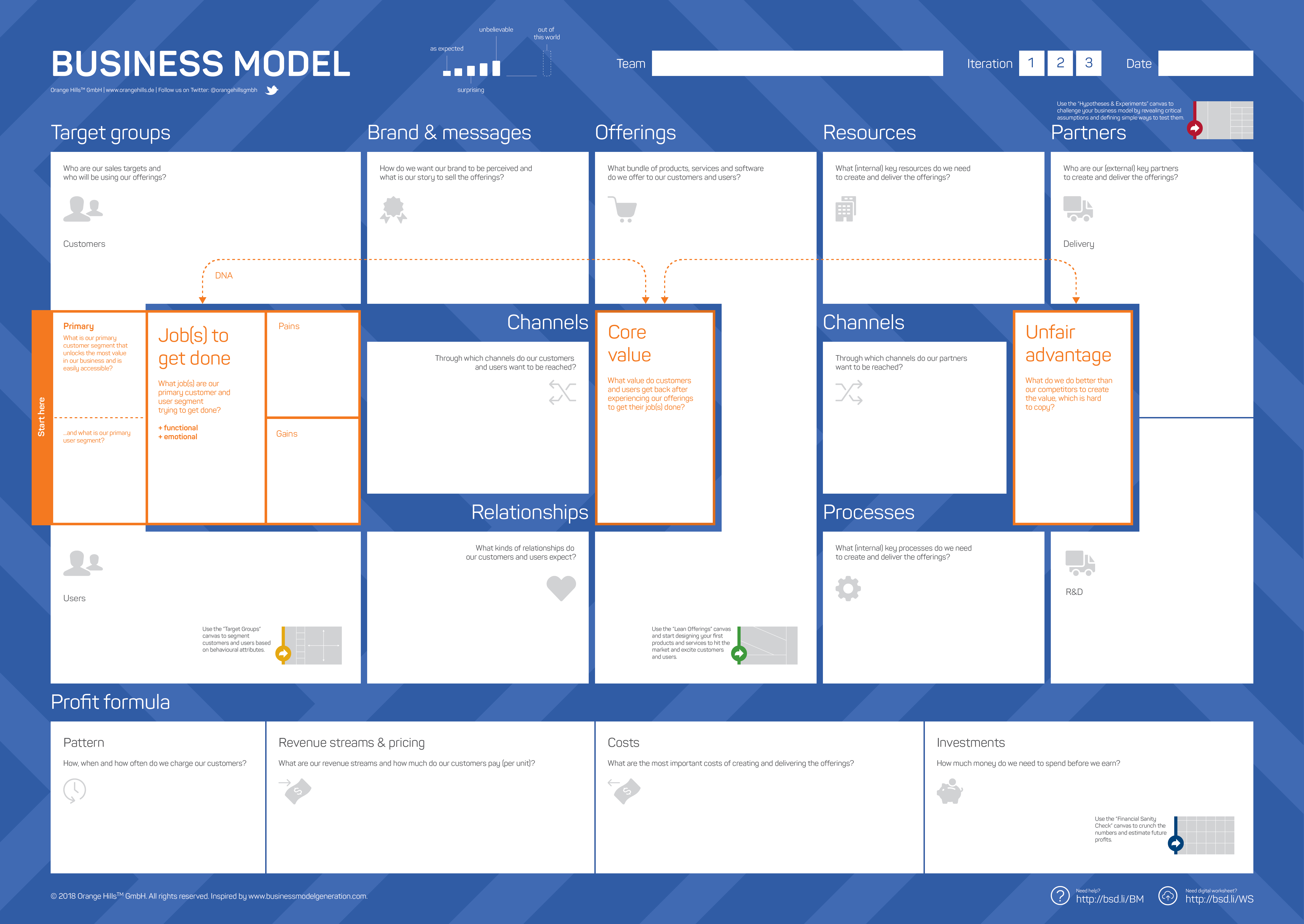Business Model
The Business Model template has been designed to visualise the essential ingredients of a business model as a future business scenario on one page. Read more about key elements, usage scenarios as well as Q&A and download the template for your team.
1. Overview
The left part focusses on external components, in order to understand the ways in which you reach and serve your customers and users. The right part comprises internal components to describe how your organisation works to create and deliver high value. The lower part of the canvas is titled ”Profit formula“ and asks questions about how you generate revenue and what costs are involved to setup and run your organisation.
The “Business DNA” is the very essence of your business model, which helps you tell a compelling story. If you had only 60 seconds to pitch your new business, you should simply focus on the DNA with respect to the questions outlined in the table below.
Think of different scenarios when designing new business models. There are always many ways to create your offerings, to serve your customers and users, and to charge them. Be as clear as possible and avoid nonsensical jargon. Whilst it is so easy just to scratch the surface, try to imagine how your new business model really works.
2. Layout & Download

3. Key Elements
Element | Question | Comments |
Target groups | Who are our sales targets and who will be using our offerings? Primary target group: What is our primary customer and user segment that unlocks the most value in our business and is easily accessible? | Good criteria to select a primary target group:
|
Brand & messages | How do we want our brand to be perceived and what is our story to sell the offerings? | Do this box at the end! It is a kind of a verbal summary in nice words |
Channels (to primary target group) | Through which channels do our customers and users want to be reached? | Keep in mind that every pot-it in the section usually costs a lot of money. Identify not more than 1-2 key marketing and sales channels |
Relationships | What kinds of relationships do our customers and users expect? | Here, we talk about attributes (e.g. personal, anonymous, self-service) |
Offerings | What bundle of products and services do we offer to our customers and users? | This section is different to original Business Model Canvas. It is not about fancy words but a very concrete picture of what the team is going to offer. |
Resources | What (internal) key resources do we need to create and deliver the offerings? | We don't need a complete list of all required resources. The purpose is to understand what are the strategically most important resources that should be kept internally. It is about the make or buy decision. |
Processes | What (internal) key processes do we need to create and deliver the offerings? | Same here. No complete list. The purpose is to understand what are the strategically most important processes and skills that should be kept internally. |
Channels (to partners) | Through which channels do our partners want to be reached? | Not always required. Only for platform business where a company has to handle many partners and, thus, needs efficient channels to reach them (e.g. partner conference). |
Partners | Who are our (external) key partners to create and deliver the offerings? | We distinguish between R&D partner (only needed once to build a new product) and delivery partners (needed every time a customer buys something). |
Profit formula |
| If you are at the very beginning of your innovation journey, postpone this discussion to later stage. |
DNA |
| Do the DNA at the end and all three boxes together in one exercise. A good "Job(s) to Get Done" statement is usually structured as follows: |
4. Usage Scenarios
Visualising today's business model
Creating "high-level" future scenarios as business models
Analysing customer's or competitors' business models
WARNING: The Business Model template is a great tool to create a high-level overview of business models. At the same time, however, it is the perfect invitation to compile a collection of "bullsh*t bingo" statements with almost no meaning. There is more to do to literally design and understand a new business.
5. Q & A
What if the team has a hard time to find clear answers to the questions of the template? It is an indication that you have either skipped the Discover phase or not executed properly. New and surprising insights are key to build a meaningful business models.
What if the space on the template is not enough for some elements? The Business Model template has been designed to create a first draft of a today's or future business model. We have other tools to visualise more detailed content (e.g. Job(s) to get done).
What if the Business Model template has been filled properly but, to be frank, it is boring? Use either the Business Model Inspirator the Big Data Inspirator or other tools (e.g. extreme goals, trigger questions) to spur on the creativity. A lack of creativity is also a sign for a lack of (surprising) insights from the Discover phase.
We sometimes use a "reduced" version of the Business Model template to create and visualise business ideas - already with a clear customer focus.
